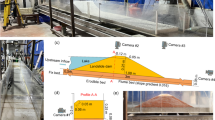Abstract
In this study, a series of natural dam overtopping laboratory tests are reported. In these tests, the effect of seven different sediment mixtures on the breaching process was investigated. According to the test results, three stages of the breaching process of natural dams made of different materials were observed. Backward erosion was the primary cause for the incising slopes. The effects of backward erosion became stronger with the larger fines contents of the materials. With an increase in the median diameter (d 50) of particles, the breaching time became longer. However, the peak discharge became smaller. With an increase in the fines contents (p), the median diameter of the particles and the void ratio were changed, which resulted in a decrease in the breaching time and an increase in the peak discharge. The breaching time and peak discharge were more sensitive to the median diameter than to the fines contents. The relation between breach width and depth was found to follow a logistic function \( W\kern0.5em =\kern0.5em \frac{\zeta }{1\kern0.5em +\kern0.5em {e}^{\left(-k\left(D\kern0.5em -\kern0.5em {D}_0\right)\right)}} \). The parameters ζ, k, and D 0 are defined by a linear relationship with the median diameter and fines content. A breach of the side slope occurred as a tensile failure when the fines contents of the materials were large; otherwise, shear failure occurred. Furthermore, when the materials had fewer fines contents, the volume of the collapsed breach side slope became larger.


















Similar content being viewed by others
References
Annandale GW (2006) Scour technology: mechanics and engineering practice. McGraw-Hill, New York
Cao Z, Yue Z, Pender G (2011) Landslide dam failure and flood hydraulics. Part I: experimental investigation. Nat Hazards 59(2):1003–1019
Casagli N, Ermini L, Rosati G (2003) Determining grain size distribution of the material composing landslide dams in the Northern Apennines: sampling and processing methods. Eng Geol 69(1):83–97
Chai HJ, Liu HC, Zhang ZY, Liu HW (2001) Preliminarily stability analysis of natural rock-field dam resulting from damming landslide. Geol Sci Technol Inf 20(1):77–81 (in Chinese)
Chen SC, Lin TW, Chen CY (2015) Modeling of natural dam failure modes and downstream riverbed morphological changes with different dam materials in a flume test. Eng Geol 188:148–158
Coleman SE, Andrews DP, Webby MG (2002) Overtopping breaching of noncohesive homogeneous embankments. J Hydraul Eng 128(9):829–838
Cui P, Zhu YY, Han YS, Chen XQ, Zhuang JQ (2009) The 12 May Wenchuan earthquake-induced landslide lakes: distribution and preliminary risk evaluation. Landslides 6(3):209–223
Dai FC, Lee CF, Deng JH, Tham LG (2005) The 1786 earthquake-triggered landslide dam and subsequent dam-break flood on the Dadu river, southwestern China. Geomorphology 65(3):205–221
Dong JJ, Li YS, Kuo CY, Sung RT, Li MH, Lee CT, Lee WR (2011) The formation and breach of a short-lived landslide dam at Hsiaolin village, Taiwan—part I: post-event reconstruction of dam geometry. Eng Geol 123(1):40–59
Ermini L, Casagli N (2003) Prediction of the behaviour of landslide dams using a geomorphological dimensionless index. Earth Surf Process Landf 28(1):31–47
Gregoretti C, Maltauro A, Lanzoni S (2010) Laboratory experiments on the failure of coarse homogeneous sediment natural dams on a sloping bed. J Hydraul Eng 136(11):868–879
He C, Han L, Zhuo Z, Zhi XU (2000) The distribution, causes and effects of damming landslides in China. J Chengdu Univ Technol 27(3):302–307
Jiang XG, Cui P, Chen HY, Guo YY (2016) Formation conditions of outburst debris flow triggered by overtopped natural dam failure. Landslides, 1–11
Li MH, Sung RT, Dong JJ, Lee CT, Chen CC (2011) The formation and breaching of a short-lived landslide dam at Hsiaolin Village, Taiwan—part II: simulation of debris flow with landslide dam breach. Eng Geol 123(1):60–71
Liu N, Chen Z, Zhang JX, Lin W, Chen W, Xu WJ (2010) Draining the Tangjiashan barrier lake. J Hydraul Eng 136(11):914–923
Mitchener H, Torfs H (1996) Erosion of mud/sand mixtures. Coast Eng 29(1–2):1–25
Morris MW, Hassan MAAM, Vaskinn KA (2007) Breach formation: field test and laboratory experiments. J Hydraulic Res 45(sup1):9–17
Pickert G, Weitbrecht V, Bieberstein A (2011) Breaching of overtopped river embankments controlled by apparent cohesion. J Hydraul Res 49(2):143–156
Rozov AL (2003) Modeling of washout of dams. J Hydraul Res 41(6):565–577
Schmocker L, Frank PJ, Hager WH (2014) Overtopping dike-breach: effect of grain size distribution. J Hydraul Res 52(4):559–564
Shang Y, Yang Z, Li L, Liu DA, Liao Q, Wang Y (2003) A super-large landslide in Tibet in 2000: background, occurrence, disaster, and origin. Geomorphology 54(3):225–243
The Professional Standards Compilation Group of People's Republic of China (1999) SL237–1999 Specification of soil test. China Water Power Press, Beijing (in Chinese)
Vallejo LE (2001) Interpretation of the limits in shear strength in binary granular mixtures. Can Geotech J 38(5):1097–1104
Vallejo LE, Mawby R (2000) Porosity influence on the shear strength of granular material–clay mixtures. Eng Geol 58(2):125–136
Van Rijn LC (1984) Sediment pick-up functions. J Hydraul Eng 110(10):1494–1502
Wu W (2013) Simplified physically based model of earthen embankment breaching. J Hydraul Eng 139(8):837–851
Xu Q, Fan XM, Huang RQ, Van Westen C (2009) Landslide dams triggered by the Wenchuan earthquake, Sichuan Province, south west China. Bull Eng Geol Environ 68(3):373–386
Zhang J, Cao SY, Yang FG, Luo LH, Huang E (2010) Experimental study on outlet and scour of blocked dam. J Sichuan Univ (Eng Sci Ed) 5:029
Zhang DW, Huang JC, He XY (2011) Experimental study on overtopping breaching of noncohesive homogeneous embankment dams. Shuikexue Jinzhan/Adv Water Sci 22(2):222–228
Zhu PY, Li T (2001) Flash flooding caused by landslide dam failure ICIMOD Newsletter No 38, available at http://www.icimod.org.np/publications/newsletter/New38/dam.htm
Acknowledgements
This research was supported by the Open fund of Key Laboratory of mountain hazards and surface processes, Chinese Academy of Sciences (KLMHESP-17-05), and the National Fundamental Scientific Research Grant of China (No. 41672304 and No. 51409181).
Author information
Authors and Affiliations
Corresponding author
Rights and permissions
About this article
Cite this article
Xiangang, J., Jiahua, H., Yunwei, W. et al. The influence of materials on the breaching process of natural dams. Landslides 15, 243–255 (2018). https://doi.org/10.1007/s10346-017-0877-9
Received:
Accepted:
Published:
Issue Date:
DOI: https://doi.org/10.1007/s10346-017-0877-9




